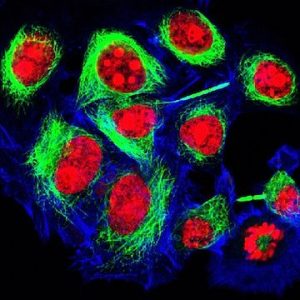As per the central dogma, protein production by translation is possible after RNA transcription and it all begins with DNA replication. In simpler terms, DNA sequence provides instructions for protein synthesis, and thus a gene expression results in protein expression. The recombinant DNA technology, also known as DNA cloning or gene cloning, involves the transfer of foreign DNA into an organism, leading to the amplification of the foreign DNA followed by protein expression of the related gene.
What is Recombinant Protein Production?
Recombinant proteins are proteins that are expressed from recombinant DNA in host cells. Recombinant protein production is used in many areas such as diagnostic tools, therapeutics, vaccines, cosmetics, food production, etc. Protein production from natural sources often does not give the desired yield or quality in the upstream processing and therefore, recombinant DNA technology provides a far more efficient method for producing the desired quality of proteins in larger amounts. For example, recombinant insulin has been used in the case of diabetes patients, and the potential to allow manipulation of the properties further enhances interest in this technology. However, concerns regarding the safety and ethics of using recombinant DNA technology do exist and undergo constant research scrutiny.
Recombinant protein production has become a widespread technique and offers ample scope of upstream processing research based on the choice of expression system and production conditions, as every protein requires different processing conditions and host environments. Currently, there are a variety of host systems for expressing recombinant proteins:
- Recombinant protein expression in E. coli
- Recombinant protein expression in yeast
- Recombinant protein expression in insect-Baculovirus
- Recombinant protein expression in mammalian cells
In these expression systems, many factors influence the production of recombinant proteins. For example, if the recombinant protein is produced too fast, the formation of inclusion bodies may occur in the host system, thus affecting production. Some recombinant proteins also need modifications like glycosylation for maintaining stability, and thus they require expression in eukaryotic systems as prokaryotic systems cannot afford such chemical modifications in the proteins.
Recombinant Protein Production In Mammalian Systems
It is estimated that several new recombinant proteins and monoclonal antibodies enter pre-clinical and clinical processing stages every year and researchers have slowly turned towards eukaryotic, especially mammalian host systems, to overcome the shortcomings of prokaryotic host systems such as post-translational modifications. Mammalian cell lines such as CHO cells, BHK cells, or human fibrosarcoma cells have been utilized for producing crucial therapeutic recombinant mammalian proteins.
In these mammalian host cells, there are some popular expression systems like DHFR and BS amplification systems that are widely used by research for optimal expression of proteins.
DHFR Amplification System
After successful commercial insulin production using bacteria hosts, expression vectors started being designed for producing recombinant proteins using mammalian cells. In CHO cells, a dihydrofolate reductase (DHFR) based amplification system is generally used for protein production. DHFR-deficient CHO cells are transfected with an expression vector (that contains the DHFR gene with weak sv40 promoter and gene of interest) under a strong CMV promoter. This system is used for amplification and expression but with the DHFR system, each amplification step takes three to four weeks, making this a time-intensive procedure. Nevertheless, DHFR expression vectors are still used to produce high protein-expressing cell lines with improved genetic elements and cell-line development parameters.
GS System
Another popular mammalian host-based example of a gene amplification system is the glutamine synthetase (GS) expression system. GS is a dominant selectable marker that is used with GS-negative CHO and NS0 cells that contain an active endogenous GS gene (CHO cells however require GS enzyme inhibitor MSX). In some cases, high specific protein productivities could be achieved without amplification in GS systems. In addition, GS-derived cell lines require no external glutamine supplementation, thus leading to a very low risk of ammonia accumulation in these systems. So far, five FDA-approved drugs have been commercialized using the GS system. As a limitation, CHO-derived clones after MSX removal is majorly researched upon.
Other Systems
Cell-line protein expression productivity depends on the functional transcriptional activity at the site of recombinant gene integration and several genetic elements can be included along with an expression vector for high specific protein productivity such as scaffold/matrix attachment regions, ubiquitous chromatin opening elements (UCOE), and stabilizing & anti-repressor (STAR). These genetic elements can improve clonal variability and transgene expression, independent of the mammalian host type.
Future research ventures guarantee further advancements in genetic recombination and genome integration, besides coming up with universal expression vector systems that might modify their genetic elements according to the host system. These recombinant protein production systems are highly crucial to drug production and therapeutics against human pathogens and disorders, and further, promote an interesting domain of Primary Cell Culture Research. For more information, contact us at info@kosheeka.com



